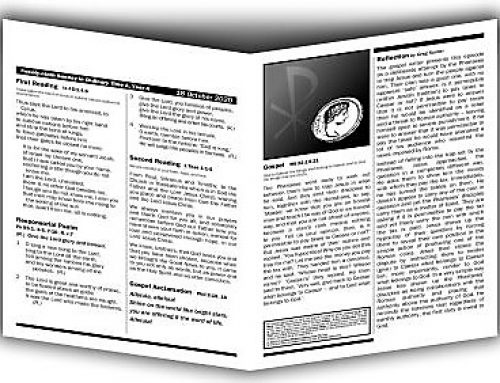With thanks to FranciscanMedia.org
Saint Catherine of Siena – 29 April
The value Catherine makes central in her short life and which sounds clearly and consistently through her experience is complete surrender to Christ. What is most impressive about her is that she learns to view her surrender to her Lord as a goal to be reached through time.
She was the 23rd child of Jacopo and Lapa Benincasa and grew up as an intelligent, cheerful, and intensely religious person. Catherine disappointed her mother by cutting off her hair as a protest against being overly encouraged to improve her appearance in order to attract a husband. Her father ordered her to be left in peace, and she was given a room of her own for prayer and meditation.
She entered the Dominican Third Order at 18 and spent the next three years in seclusion, prayer, and austerity. Gradually, a group of followers gathered around her—men and women, priests and religious. An active public apostolate grew out of her contemplative life. Her letters, mostly for spiritual instruction and encouragement of her followers, began to take more and more note of public affairs. Opposition and slander resulted from her mixing fearlessly with the world and speaking with the candor and authority of one completely committed to Christ. She was cleared of all charges at the Dominican General Chapter of 1374.
Her public influence reached great heights because of her evident holiness, her membership in the Dominican Third Order, and the deep impression she made on the pope. She worked tirelessly for the crusade against the Turks and for peace between Florence and the pope.
In 1378, the Great Schism began, splitting the allegiance of Christendom between two, then three, popes and putting even saints on opposing sides. Catherine spent the last two years of her life in Rome, in prayer and pleading on behalf of the cause of Pope Urban VI and the unity of the Church. She offered herself as a victim for the Church in its agony. She died surrounded by her “children” and was canonized in 1461.
Catherine ranks high among the mystics and spiritual writers of the Church. In 1939, she and Francis of Assisi were declared co-patrons of Italy. Pope Paul VI named her and Teresa of Avila doctors of the Church in 1970. Her spiritual testament is found in The Dialogue.
Patron Saint of St Catherine’s Catholic College Singleton, Europe, Fire Prevention, Italy
Saint Pius V – 30 April
This is the pope whose job it was to implement the historic Council of Trent. If we think popes had difficulties in implementing Vatican Council II, Pius V had even greater problems after Trent four centuries earlier.
During his papacy (1566-1572), Pius V was faced with the almost overwhelming responsibility of getting a shattered and scattered Church back on its feet. The family of God had been shaken by corruption, by the Reformation, by the constant threat of Turkish invasion, and by the bloody bickering of the young nation-states. In 1545, a previous pope convened the Council of Trent in an attempt to deal with all these pressing problems. Off and on over 18 years, the Fathers of the Church discussed, condemned, affirmed, and decided upon a course of action. The Council closed in 1563.
Pius V was elected in 1566 and charged with the task of implementing the sweeping reforms called for by the Council. He ordered the founding of seminaries for the proper training of priests. He published a new missal, a new breviary, a new catechism, and established the Confraternity of Christian Doctrine classes for the young. Pius zealously enforced legislation against abuses in the Church. He patiently served the sick and the poor by building hospitals, providing food for the hungry, and giving money customarily used for the papal banquets to poor Roman converts. His decision to keep wearing his Dominican habit led to the custom–to this day–of the pope wearing a white cassock.
In striving to reform both Church and state, Pius encountered vehement opposition from England’s Queen Elizabeth and the Roman Emperor Maximilian II. Problems in France and in the Netherlands also hindered Pius’s hopes for a Europe united against the Turks. Only at the last minute was he able to organize a fleet which won a decisive victory in the Gulf of Lepanto, off Greece, on October 7, 1571.
Pius’ ceaseless papal quest for a renewal of the Church was grounded in his personal life as a Dominican friar. He spent long hours with his God in prayer, fasted rigorously, deprived himself of many customary papal luxuries, and faithfully observed the spirit of the Dominican Rule that he had professed.
Patron Saint of Valletta, Malta
Saint Joseph the Worker – 1 May
To foster deep devotion to Saint Joseph among Catholics, and in response to the “May Day” celebrations for workers sponsored by Communists, Pope Pius XII instituted the feast of Saint Joseph the Worker in 1955. This feast extends the long relationship between Joseph and the cause of workers in both Catholic faith and devotion. Beginning in the Book of Genesis, the dignity of human work has long been celebrated as a participation in the creative work of God. By work, humankind both fulfills the command found in Genesis to care for the earth (Gn 2:15) and to be productive in their labors. Saint Joseph, the carpenter and foster father of Jesus, is but one example of the holiness of human labor.
Jesus, too, was a carpenter. He learned the trade from Saint Joseph and spent his early adult years working side-by-side in Joseph’s carpentry shop before leaving to pursue his ministry as preacher and healer. In his encyclical Laborem Exercens, Pope John Paul II stated: “the Church considers it her task always to call attention to the dignity and rights of those who work, to condemn situations in which that dignity and those rights are violated, and to help to guide [social] changes so as to ensure authentic progress by man and society.”
Saint Joseph is held up as a model of such work. Pius XII emphasized this when he said, “The spirit flows to you and to all men from the heart of the God-man, Savior of the world, but certainly, no worker was ever more completely and profoundly penetrated by it than the foster father of Jesus, who lived with Him in closest intimacy and community of family life and work.”
Saint Athanasius – 2 May
Athanasius led a tumultuous but dedicated life of service to the Church. He was the great champion of the faith against the widespread heresy of Arianism, the teaching by Arius that Jesus was not truly divine. The vigor of his writings earned him the title of doctor of the Church.
Born of a Christian family in Alexandria, Egypt, and given a classical education, Athanasius became secretary to Alexander, the bishop of Alexandria, entered the priesthood and was eventually named bishop himself. His predecessor, Alexander, had been an outspoken critic of a new movement growing in the East—Arianism.
When Athanasius assumed his role as bishop of Alexandria, he continued the fight against Arianism. At first, it seemed that the battle would be easily won and that Arianism would be condemned. Such, however, did not prove to be the case. The Council of Tyre was called and for several reasons that are still unclear, the Emperor Constantine exiled Athanasius to northern Gaul. This was to be the first in a series of travels and exiles reminiscent of the life of Saint Paul.
After Constantine died, his son restored Athanasius as bishop. This lasted only a year, however, for he was deposed once again by a coalition of Arian bishops. Athanasius took his case to Rome, and Pope Julius I called a synod to review the case and other related matters.
Five times Athanasius was exiled for his defense of the doctrine of Christ’s divinity. During one period of his life, he enjoyed 10 years of relative peace—reading, writing, and promoting the Christian life along the lines of the monastic ideal to which he was greatly devoted. His dogmatic and historical writings are almost all polemic, directed against every aspect of Arianism.
Among his ascetical writings, his Life of St. Anthony achieved astonishing popularity and contributed greatly to the establishment of monastic life throughout the Western Christian world.
Saints Philip and James – 3 May
James, Son of Alphaeus: We know nothing of this man except his name, and, of course, the fact that Jesus chose him to be one of the 12 pillars of the New Israel, his Church. He is not the James of Acts, son of Clopas, “brother” of Jesus and later bishop of Jerusalem and the traditional author of the Letter of James. James, son of Alphaeus, is also known as James the Lesser to avoid confusing him with James the son of Zebedee, also an apostle and known as James the Greater.
Philip: Philip came from the same town as Peter and Andrew, Bethsaida in Galilee. Jesus called him directly, whereupon he sought out Nathanael and told him of the “one about whom Moses wrote” (Jn 1:45).
Like the other apostles, Philip took a long time coming to realize who Jesus was. On one occasion, when Jesus saw the great multitude following him and wanted to give them food, he asked Philip where they should buy bread for the people to eat. Saint John comments, “[Jesus] said this to test him, because he himself knew what he was going to do” (Jn 6:6). Philip answered, “Two hundred days’ wages worth of food would not be enough for each of them to have a little [bit]” (Jn 6:7).
John’s story is not a put-down of Philip. It was simply necessary for these men who were to be the foundation stones of the Church to see the clear distinction between humanity’s total helplessness apart from God and the human ability to be a bearer of divine power by God’s gift.
On another occasion, we can almost hear the exasperation in Jesus’s voice. After Thomas had complained that they did not know where Jesus was going, Jesus said, “I am the way. If you know me, then you will also know my Father. From now on you do know him and have seen him” (Jn 14:6a, 7). Then Philip said, “Master, show us the Father, and that will be enough for us” (Jn 14:8). Enough! Jesus answered, “Have I been with you for so long a time and you still do not know me, Philip? Whoever has seen me has seen the Father” (Jn 14:9a).
Possibly because Philip bore a Greek name or because he was thought to be close to Jesus, some gentile proselytes came to him and asked him to introduce them to Jesus. Philip went to Andrew, and Andrew went to Jesus. Jesus’s reply in John’s Gospel is indirect; Jesus says that now his “hour” has come, that in a short time he will give his life for Jew and gentile alike.
Patron Saints of Uruguay





